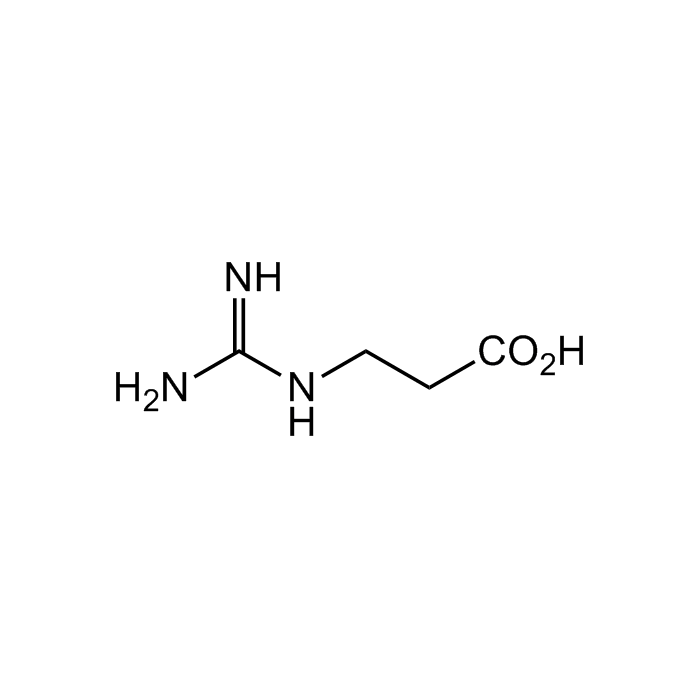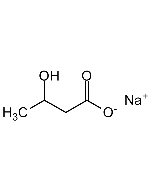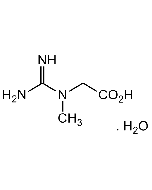Cookie Policy: This site uses cookies to improve your experience. You can find out more about our use of cookies in our Privacy Policy. By continuing to browse this site you agree to our use of cookies.
AdipoGen Life Sciences
3-Guanidinopropionic acid
As low as
40
CHF
CHF 40.00
In stock
Only %1 left
AG-CR1-3678-M500500 mgCHF 40.00
AG-CR1-3678-G0011 gCHF 70.00

| Product Details | |
|---|---|
| Synonyms | β-GPA; PNU 10483; N-(Aminoiminomethyl)-β-alanine |
| Product Type | Chemical |
| Properties | |
| Formula |
C4H9N3O2 |
| MW | 131.1 |
| CAS | 353-09-3 |
| RTECS | AY3157500 |
| Purity Chemicals | ≥98% |
| Appearance | White powder. |
| Solubility | Soluble in water (50mg/ml) or other aqueous buffers (e.g. PBS). |
| InChi Key | KMXXSJLYVJEBHI-UHFFFAOYSA-N |
| Smiles | NC(NCCC(O)=O)=N |
| Shipping and Handling | |
| Shipping | AMBIENT |
| Short Term Storage | +4°C |
| Long Term Storage | -20°C |
| Handling Advice |
Keep cool and dry. Aqueous solutions should not be stored for longer than one day. |
| Use/Stability |
Stable for at least 2 years after receipt when stored at -20°C. Store solutions at -20°C in the dark. |
| Documents | |
| MSDS |
 Download PDF Download PDF |
| Product Specification Sheet | |
| Datasheet |
 Download PDF Download PDF |
Description
- Competitive creatine uptake inhibitor.
- Creatine analog that alters skeletal muscle energy expenditure.
- Thermogenesis inhibitor. Inhibitor of energy expenditure through reduction of ATP.
- AMPK stimulator and PGC-1α activator. Reduces cellular ATP, creatine and phosphocreatine levels, consequently stimulating AMP-activated protein kinase (AMPK) and activating PPARγ coactivator 1α (PGC-1α).
- Evokes a shift from glycolytic to oxidative metabolism, increased cellular glucose uptake and increased fatigue tolerance.
- Ameliorates hyperglycemia in animal models of non-insulin-dependent diabetes (NIDDM). Improved insulin sensitivity and promoted weight loss selectively from adipose tissue.
- Studied for potential use during protein refolding as an anti-aggregatory molecule similar to L-arginine.
Product References
- Energy metabolism of skeletal muscle containing cyclocreatine phosphate. Delay in onset of rigor mortis and decreased glycogenolysis in response to ischemia or epinephrine: T.M. Annesley & J.B. Walker; J. Biol. Chem. 255, 3924 (1980)
- Biochemical adaptation in the skeletal muscle of rats depleted of creatine with the substrate analogue β-guanidinopropionic acid: E.A. Shoubridge, et al.; Biochem. J. 232, 125 (1985)
- Antihyperglycemic action of guanidinoalkanoic acids: 3-guanidinopropionic acid ameliorates hyperglycemia in diabetic KKAy and C57BL6Job/ob mice and increases glucose disappearance in rhesus monkeys: M.D. Meglasson, et al.; J. Pharmacol. Exp. Ther. 266, 1454 (1993)
- Synthesis and biological activity of analogues of the antidiabetic/antiobesity agent 3-guanidinopropionic acid: discovery of a novel aminoguanidinoacetic acid antidiabetic agent: S.D. Larsen, et al.; J. Med. Chem. 44, 1217 (2001)
- Aging-associated reductions in AMP-activated protein kinase activity and mitochondrial biogenesis: R.M. Reznick, et al.; Cell Metab. 5, 151 (2007)
- Impaired PGC-1α function in muscle in Huntington's disease: R.K. Chaturvedi, et al.; Hum. Mol. Gen. 18, 3048 (2009)
- The effect of the creatine analogue beta-guanidinopropionic acid on energy metabolism: a systematic review: I. Oudman, et al.; PLoS One 8, e52879 (2013) (Review)
- Genetic depletion of adipocyte creatine metabolism inhibits diet-induced thermogenesis and drives obesity: L. Kazak, et al.; Cell Metab. 26, 660 (2017)
- Creatine fuels the thermic effect of feeding: A.R. Saltiel; Cell Metab. 26, 594 (2017) (Review)
- β-GPA treatment leads to elevated basal metabolic rate and enhanced hypoxic exercise tolerance in mice: T.T. Ross, et al.; Physiol. Rep. 5, e13192 (2017)









